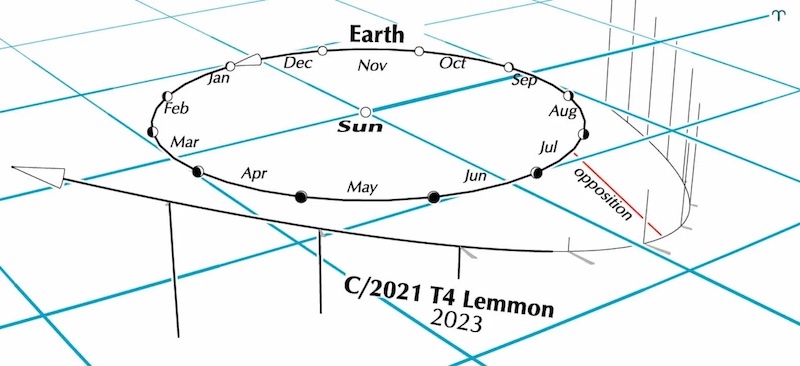Famous British astronomer Guy Ottewell This piece about Comet C/2021 T4 Lemmon was originally published on May 25, 2023. Reprinted with permission. EarthSky edits.
Comet C/2021 T4 Lemmon
Comet C/2021 T4 Lemmon was discovered on October 7, 2021, in images taken at Mount Lemmon Observatorynortheast of Tucson in Arizona. Q4 means the 4th discovery or recovery in the first half of October.
Mount Lemmon is the highest point of the Santa Catalina Mountains, one of four mountain ranges around Tucson. This is not to be confused with Catilina, the conspirator who attempted to seize power in the Roman republic in 63 BCE. I remember my speculation that the Navajo might have seen Canopus, the great star of the south, from one of the four sacred peaks that surrounded their land. In fact, it is shown as the cover image for Astronomical Calendar 2023.
When discovered, comet C/2021 T4, due to the geometry of its orbit, appeared to the north, at a declination of +12°.
Comet C/2021 T4 Lemmon is a long period comet
In fact, it is a long-period comet; if it ever descended from its distant home – at 44,000 AU out – into the inner solar system, it was millions of years ago. So during its current passage, it will feel gravitational disturbances from planets that would shorten its time to only thousands of years.
Its orbit is inclined about 20° to the ecliptic plane. However, it is going in a retrograde direction, or opposite to the direction in which the planets rotate. The result is that it will make a very long rapid sweep across our southern sky.
Locator chart
Currently, the comet is 60° in the morning sky, due south (at declination -13°), 1.75 AU from the sun and 2 AU from Earth. However, it is still of dim magnitude about 11. Then, on June 27, 2023, its distance from us will decrease to 1 AU.
On July 18, 2023, we will pass it to the opposition. And at this time, it will be closest to us, 0.54 AU, and brightest, maybe about 8 or 7 magnitude but still below the limit of the unaided eye. Its proximity would make it appear even farther south, at declination -56° on July 20.
Then, over the next few months it will climb north, becoming lower in the night sky and farther away. At the same time, it will darken by perhaps 2 or 3 magnitudes. It will reach perihelion1.48 AU from the sun, on July 31, 2023. It will finally ascend the ecliptic on September 10, 2023, and will be aligned behind and north of the sun on November 9, 2023.
Of course, we must remember that predictions of a comet’s brightness, and the size of their tails, can be unreliable. That’s because they rely on the melting of ice and the release of dust in these lumpy, rotating objects.
Comet-Hale Bopp still being noticed? Wow!
By the way, Alan Hale We (Guy Ottewell) were alerted to this comet by a Facebook post on May 22. Alan was the discoverer of the great comet Hale-Bopp (C/1995 O1). And, despite now being more than 47 AU away, it is the first of Minor Planet Center’s list of currently visible comets, not by their current magnitude (about 20) but because it is the earliest numbered non-periodic comet is still considered universally observable.
Bottom line: Comet C/2021 T4 Lemmon was discovered from the Mount Lemmon Observatory in 2021. It is currently penetrating the southern sky.


